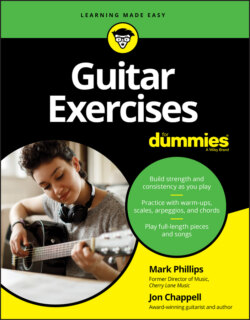Читать книгу Guitar Exercises For Dummies - Jon Chappell - Страница 6
Conventions We Use in This Book
ОглавлениеBecause we assume that you already play the guitar a little and are familiar with practice drills and exercises, we adopt certain conventions in this book and adhere to certain accepted terms and practices for guitar playing. For example, when we say up we typically mean higher in pitch, whether it’s referring to a string (the high E string) or to a position. So “going up the neck” means heading in the direction of the bridge, not the nut. Down means lower in pitch or lower on the neck (toward the nut and headstock).
Notice, too, that throughout this book, we call the hand that you fret notes with the left hand, even though some left-handed people will turn the guitar over, string it in reverse, and fret with their right hand. But rather than say “fretting hand” and “picking hand,” we use “left hand” and “right hand,” respectively. We beg the forgiveness of southpaws everywhere.
We employ a bit of logic in the ordering of the figures presented. For example, you may notice that we introduce the major scale before the minor one. And for the three types of minor scales presented, we start with the natural minor scale. We do this because scales have a conventional order of presentation, not because, say, the major scale is necessarily easier to play than the minor scale. Also note that we always present the various patterns for both scales and arpeggios based on their starting notes — moving from low to high within a given position.
In the music figures, we introduce each new scale with a neck diagram showing you where to put your fingers on the frets and strings. The left-hand finger indications appear inside the circles (1 = index, 2 = middle, 3 = ring, and 4 = little), and the tonic, or name tone, of the scale appears as a white number in a black circle. The corresponding music notation is presented without bar lines. We do this to show you that it’s not meant to be played in a particular meter but instead is a figure you can use to see and hear the scale without worrying about the rhythmic context. The tab staff that’s presented below the figures shows the corresponding string and tab numbers, and below that are the letter names of the pitches, with the tonics circled.
Additionally, we always provide the starting left-hand finger, which appears just to the left of the first note in the standard music staff. If we offer other left-hand fingers within the figure, it’s to signal that you’re playing an out-of-position note, or to remind you which finger takes you back into position after having just played an out-of-position note. (By the way, an out-of-position note is one that doesn’t fall within the four-fret span defined by the position and that requires a stretch by the 1st or 4th finger to play it.) Keep in mind that these fingerings serve as gentle reminders only. If you can play out-of-position notes using fingerings that are more comfortable or more logical, please feel free to do so. Just be sure to get back on track with the correct fingering as quickly as possible so that the following notes will be played in the proper position.
We don’t provide notation for the right hand because you can play these exercises either with your individual right-hand fingers or with a flatpick. If you play with your fingers, practice the scales and arpeggios by alternating your index and middle or the middle and ring fingers. If using a pick is more your style, play the scales using alternate picking — playing downstrokes and upstrokes in an alternating motion, starting with a downstroke on the first note. Sometimes we tell you when a certain scale or arpeggio may favor one approach over the other, but you can play any exercise in this book using either right-hand technique. Many well-rounded guitarists play both fingerstyle and with a pick, and you’re encouraged to do the same with these exercises.
You’ll notice black track boxes above the music figures in this book. These boxes tell you the track number that the recorded version appears on. In these boxes, we sometimes include the starting time within the track. In many instances, multiple figures are included in a single track, so the timing helps to separate them. A time of 0:00 means the figure is the first one on the track.
And don’t forget about the usual For Dummies convention that has us italicizing any important new words that you may need for the topic at hand. These italicized words are always followed by a clear, easy-to-read definition.
